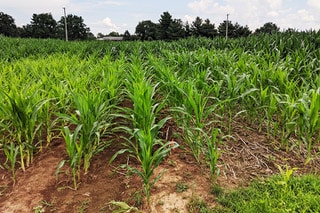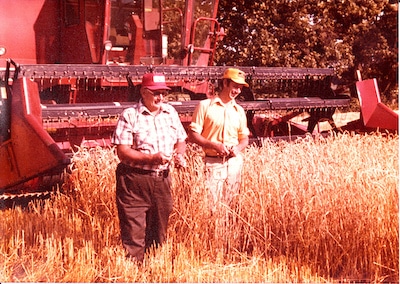
No-till field at the University of Kentucky; Photo courtesy of the University of Kentucky College of Agriculture, Food & Environment.
Climate change, sustainability, regenerative agriculture, Earth Day — these are words that can excite and ignite action while also creating anxiety and concern. With the recent annual celebration of Earth Day, highlights of the climate crisis and successes are in the headlines. But for those who grow and produce food every day, Earth Day extends beyond an April 22 hashtag or social media post.
Despite what headlines suggest, the commitment to sustainable agriculture didn’t start yesterday. The search for solutions for growing food more sustainably has been the mission of those committed to the land for decades. Farmers, like all consumers, want a sustainable environment.
Agriculture is core to our personal and planet survival — but it takes commitment and financial investment. That commitment started years ago on the farm, with one farmer seeking to improve soil health and leading to the birth of no-till.
It’s About Technology
Farming is no different than any other industry or organization, sustainability is survival. Today’s farmland is a result of improved preservation of natural resources over time. The 1930s Dust Bowl was a wakeup call for conserving the soil, resulting in the formation of the USDA Soil Conversation Service, now the USDA National Resources Conversation Services (NRCS). What was known as “soil conservation” during my childhood, has morphed into today’s broader concept of sustainability.

Harry and John Young. Photo courtesy of Alexander Young. From University of Kentucky College of Agriculture, Food & Environment.
Now, when we talk about sustainable farming practices, no-tillage production is highlighted as a new technology and production standard. It is not a century old method, but it’s not new. Thanks to the inquisitive mind of one western Kentucky farmer, who was willing to try what he had learned from seminars and reading, no-till production began in 1962.
Harry Young, a western Kentucky farmer is credited as the pioneer of no-tillage production. Young, along with Dr. Shirley Phillips, a University of Kentucky agronomist, worked to perfect a method that kept land in production at a crucial time. Historical documents reflect that Young’s implementation of no-till cropping was pivotal during a time when farmers were facing soil erosion from plowed fields, especially those with rolling hills.
Early adopters of the production method spread across the state over the next decade or so, with conservation minded farmers like my father joining the movement. By the late 1970s, the Smiths began no-till planting our corn. The goal, less disturbance of the soil, minimized erosion on the rolling hills of northern Kentucky.
The Commitment to Solutions
Like any new process or procedure, something new doesn’t start without bumps along the way and the commitment to continuous improvement. Despite the immediate improvement in soil health, issues of weed control, yield and yes — even overcoming personal pride of a less than attractive field during planting — were challenges to overcome in the early days. These challenges led to solutions.
With advances in weed control and equipment inventions such as the row cleaner (by one of Young’s area farmers, Howard Martin) seeds could be planted into the soil deeper allowing germination to occur at maximum level. With better germination, improved crop yields and wider adoption of the production method followed.1

Edge family farm in Ohio County, Kentucky
While some soil types and climates may limit the adoption of no-tillage cropping, the overall movement to conservation tillage practices, including strip and mulch till, continues to grow. Currently, our corn and soybean fields in Western Kentucky are planted using a combination of no-till and strip till due to the soil type and typography.
The Critical Research Factor
Chad Lee, director of the University of Kentucky (UK) Grain and Forage Center of Excellence, confirms that the benefit of no-till production is evident and can offset the negatives. With improved health and water holding capacity of the soil, the nutrient and chemical run-off into our public water streams is minimized.1 Additionally, fuel and labor costs are reduced without a decline in crop yields. However, financial investment in specialized equipment is a reality that must be calculated into the sustainability equation.
The commitment to no-tillage agriculture research remains strong at UK but has moved from adoption of the process to enhancing process benefits. UK professors like Hanna Poffenbarger are focused on helping farmers navigate the next set of challenges. For example, her current research focuses on ways cover crops can complement no-tillage systems, highlighting the production’s carbon sequestration benefit; a benefit that serves all of us.1
From Idea to Inspiration — An Agricultural Revolution
What started as an idea generated in 1943 by Edward Faulkner, an Ohio-based Extension agriculture agent, in his book, Plowman’s Folly, grew to inspiration and reality for Harry Young. Faulkner’s book focused on understanding the value of limiting soil disruption, upholding his philosophy that “no one has ever advanced a scientific reason for plowing.” Inspired, Young started the no-tillage experiment on less than one acre. That experiment now has evolved to 104+ million acres of crop land in no-till production across the U.S and the world … thanks to like-minded farmers and academics like Young and Phillips.
As Jeff Young, grandson of Harry Young, stated in a UK article, “It has been said that if we take care of the land, then it will take care of us. What’s more, disturbing the ground that feeds us any more than necessary costs money, time and valuable organic matter.”1 John Young added that his family’s role in revolutionizing agriculture is more about being part of the solution to one of mankind’s shared challenges than just pride.
Just imagine, if we all would think like Harry Young …
References
1. Pratt, K. “No-Tillage Agriculture: A Legacy Born in Kentucky,” University of Kentucky College of Agriculture, Food, & Environment. 2022. https://news.ca.uky.edu/article/no-tillage-agriculture-legacy-born-kentucky.
Resources
- Earth Day
- USDA National Resources Conversation Services (NRCS)
- “No-Till’s List of Legends,” Frank Lessiter, No-Till Farming 101, Seeding & Planting, Residue Management, Nutrient Management, Soil Health, No-Till Farmer
